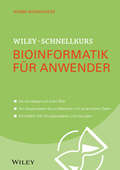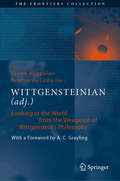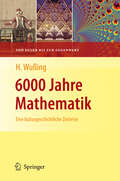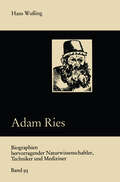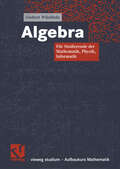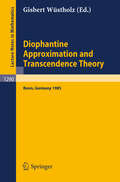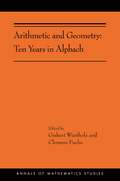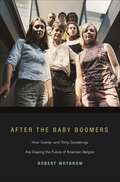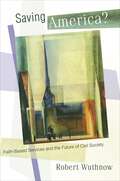- Table View
- List View
Differentialgeometrie: Kurven und Flächen (Mathematik für Ingenieure und Naturwissenschaftler, Ökonomen und Landwirte)
by Volkmar WünschDie Geschichte der Differentialgeometrie ist eng mit der Entwicklung der Infini tesimalrechnung und der analytischen Geometrie einerseits, mit der Geodäsie, der Kartographie und der Physik andererseits verknüpft. Sie ist zwar durch Idealisierung der Erfahrungswelt entstanden, hat sich aber im Laufe der letzten beiden Jahrhunderte zu einer deduktiven, mit strengen Beweisen arbeitenden Wissenschaft herausgebildet. Heute sind zahlreiche Disziplinen der Mathema tik, aber auch der Physik und Technik mit differentialgeometrischen Begriffs bildungen durchsetzt. Diese interdisziplinäre Verzahnung -man denke etwa an die Darstellung geometrischer Objekte mit den Methoden der Numerik und Informatik (CAGD) oder an die Geometrisierung der modernen Physik -hält unvermindert an. Mit dem vorliegenden Buch wird einem möglichst großen Interessentenkreis eine brauchbare Grundlage für eine klassisch-und anwendungsorientierte Kurven und Flächentheorie geliefert. In der Differentialgeometrie kann ein Studieren der die in der Differential- und Integralrechnung sowie in der analytischen Geometrie erworbenen Techniken anwenden und geometrische Vorstellungen entwickeln. Dem Leser sollen Brücken zwischen Theorie und Praxis aufgezeigt werden. Im Vordergrund stehen die lokale Differentialgeometrie und ihre An wendungsmöglichkeiten, wobei lokale und globale Aspekte klar unterschieden werden. Gelegentlich wird dem technisch Wichtigen der Vorrang vor dem geo metrisch Wertvollen eingeräumt. Gleichwohl sollen die technischen Anwendun gen nicht von den geometrischen Grundgedanken ablenken. Differentialgeo metrie wird eben nicht nur als Grundlage technischer Bildung, sondern auch wegen ihres Stellenwertes im Rahmen der Mathematik und ihrer kulturellen Bedeutung betrieben.
Wiley-Schnellkurs Bioinformatik für Anwender (Wiley Schnellkurs)
by Röbbe WünschiersDie digitale Datenverarbeitung wird auch für Lebenswissenschaftler immer wichtiger. Hier setzt dieser Schnellkurs an. Röbbe Wünschiers erklärt Ihnen, wie Sie mit Sequenz-, Struktur- und anderen Daten umgehen sollten. Er erläutert, wie Sie Linux als virtuelle Maschine installieren und wie Ihnen Linuxtools wie Sed oder die einfache Programmiersprache AWK bei der Datenanalyse helfen können. Außerdem führt er Sie knapp in weitere Bereiche ein, die Ihnen das digitale Leben erleichtern können: das Datenbanksystem MariaDB/MySQL, die Programmierumgebung R für statistisches Rechnen und Datenvisualisierung, die Textsatzsprache LaTeX und einiges mehr. Ausgearbeitete Beispiele aus den Lebenswissenschaften und Übungsaufgaben samt Lösungen helfen Ihnen Ihr Wissen zu festigen und zu überprüfen. Auf der Webseite datenmassen.de finden sich alle Daten und Abbildungen zum Download.
WITTGENSTEINIAN: Looking at the World from the Viewpoint of Wittgenstein's Philosophy (The Frontiers Collection)
by Shyam Wuppuluri Newton Da Costa“Tell me," Wittgenstein once asked a friend, "why do people always say, it was natural for man to assume that the sun went round the earth rather than that the earth was rotating?" His friend replied, "Well, obviously because it just looks as though the Sun is going round the Earth." Wittgenstein replied, "Well, what would it have looked like if it had looked as though the Earth was rotating?” What would it have looked like if we looked at all sciences from the viewpoint of Wittgenstein’s philosophy? Wittgenstein is undoubtedly one of the most influential philosophers of the twentieth century. His complex body of work has been analysed by numerous scholars, from mathematicians and physicists, to philosophers, linguists, and beyond. This volume brings together some of his central perspectives as applied to the modern sciences and studies the influence they may have on the thought processes underlying science and on the world view it engenders. The contributions stem from leading scholars in philosophy, mathematics, physics, economics, psychology and human sciences; all of them have written in an accessible style that demands little specialist knowledge, whilst clearly portraying and discussing the deep issues at hand.
The Map and the Territory: Exploring the Foundations of Science, Thought and Reality (The Frontiers Collection)
by Shyam Wuppuluri Francisco Antonio DoriaThis volume presents essays by pioneering thinkers including Tyler Burge, Gregory Chaitin, Daniel Dennett, Barry Mazur, Nicholas Humphrey, John Searle and Ian Stewart. Together they illuminate the Map/Territory Distinction that underlies at the foundation of the scientific method, thought and the very reality itself. It is imperative to distinguish Map from the Territory while analyzing any subject but we often mistake map for the territory. Meaning for the Reference. Computational tool for what it computes. Representations are handy and tempting that we often end up committing the category error of over-marrying the representation with what is represented, so much so that the distinction between the former and the latter is lost. This error that has its roots in the pedagogy often generates a plethora of paradoxes/confusions which hinder the proper understanding of the subject. What are wave functions? Fields? Forces? Numbers? Sets? Classes? Operators? Functions? Alphabets and Sentences? Are they a part of our map (theory/representation)? Or do they actually belong to the territory (Reality)? Researcher, like a cartographer, clothes (or creates?) the reality by stitching multitudes of maps that simultaneously co-exist. A simple apple, for example, can be analyzed from several viewpoints beginning with evolution and biology, all the way down its microscopic quantum mechanical components. Is there a reality (or a real apple) out there apart from these maps? How do these various maps interact/intermingle with each other to produce a coherent reality that we interact with? Or do they not?Does our brain uses its own internal maps to facilitate “physicist/mathematician” in us to construct the maps about the external territories in turn? If so, what is the nature of these internal maps? Are there meta-maps? Evolution definitely fences our perception and thereby our ability to construct maps, revealing to us only those aspects beneficial for our survival. But the question is, to what extent? Is there a way out of the metaphorical Platonic cave erected around us by the nature? While “Map is not the territory” as Alfred Korzybski remarked, join us in this journey to know more, while we inquire on the nature and the reality of the maps which try to map the reality out there. The book also includes a foreword by Sir Roger Penrose and an afterword by Dagfinn Follesdal.
From Electrons to Elephants and Elections: Exploring the Role of Content and Context (The Frontiers Collection)
by Shyam Wuppuluri Ian StewartThis highly interdisciplinary book, covering more than six fields, from philosophy and sciences all the way up to the humanities and with contributions from eminent authors, addresses the interplay between content and context, reductionism and holism and their meeting point: the notion of emergence. Much of today’s science is reductionist (bottom-up); in other words, behaviour on one level is explained by reducing it to components on a lower level. Chemistry is reduced to atoms, ecosystems are explained in terms of DNA and proteins, etc. This approach fails quickly since we can’t cannot extrapolate to the properties of atoms solely from Schrödinger's equation, nor figure out protein folding from an amino acid sequence or obtain the phenotype of an organism from its genotype. An alternative approach to this is holism (top-down). Consider an ecosystem or an organism as a whole: seek patterns on the same scale. Model a galaxy not as 400 billion-point masses (stars) but as an object in its own right with its own properties (spiral, elliptic). Or a hurricane as a structured form of moist air and water vapour. Reductionism is largely about content, whereas holistic models are more attuned to context. Reductionism (content) and holism (context) are not opposing philosophies — in fact, they work best in tandem. Join us on a journey to understand the multifaceted dialectic concerning this duo and how they shape the foundations of sciences and humanities, our thoughts and, the very nature of reality itself.
On Art and Science: Tango of an Eternally Inseparable Duo (The Frontiers Collection)
by Shyam Wuppuluri Dali WuEinstein once remarked "After a certain high level of technical skill is achieved, science and art tend to coalesce in aesthetics, plasticity, and form. The greatest scientists are always artists as well". In this volume, some of the world’s leading thinkers come together to expound on the interrelations between sciences and arts. While one can segregate art and place it outside the scientific realm, it is, nevertheless, inextricably linked to our essential cognitive/emotional/perceptual modalities and abilities, and therefore lies alongside and in close contact with the method of science and philosophy. What inspiration can scientists draw from art and how can scientific spirit foster our understanding and creation of aesthetic works? How are art and science grounded in our cognition? What role does perception play in science and art? Are criteria for beauty in art and science the same? How does evolution shape our understanding of art? How do science, art and scientifico-artistic frameworks shape society as a whole and help us address its pressing issues? The epistemological and ontological aspects haunt artists, philosophers and scientists alike. The essays in this volume address these manifold questions while also elucidating the pragmatic role they play in our daily life.
Einstieg in die Wirtschaftsmathematik
by Uwe Würker6 mathematische Lösungsmethoden bei der Untersuchung der ihn interessieren den Fragen helfen können. Dieses Anliegen wird im Buch dadurch realisiert, daß die behandelten mathematischen Themen an vielen Anwendungsbeispie len illustriert werden und daß großer Wert auf die Interpretation der erzielten Ergebnisse gelegt wird. Die Darlegungen des Buches berücksichtigen natürlich, daß ein Student im l. Semester noch kein fertig ausgebildeter Wirtschaftswissenschaftler ist. Deshalb werden sehr spezielle Fachtermini vermieden. Zur Anregung der selbständi gen Beschäftigung mit dem behandelten Stoff werden dafür eine große Zahl an Übungsaufgaben gestellt, von denen in der Regel auch die Lösungen im Anhang zu finden sind. Schließlich ist die Vielzahl im Buch enthaltener Abbildungen dazu gedacht, das Vorstellungsvermögen anzuregen und zu verbessern. Das vorliegende Lehrbuch vereint gewissermaßen drei Bücher in einem: einen Vorkurs zum Erwerb oder zur Festigung von Abiturkenntnissen, den ei gentlichen Grundkurs Mathematik für Wirtschaftswissenschaftler, der die Ge biete Lineare Algebra, Lineare Optimierung und Analysis mehrerer Veränder licher umfaßt, sowie eine relativ umfangreiche Einführung in die Finanzma thematik. Nicht unerwähnt sollte bleiben, daß das Buch so angelegt ist, daß es sich auch vorzüglich zum Selbststudium eignet. Erfreulicherweise stieß die erste Ausgabe auf eine rege Nachfrage, so daß be reits nach relativ kurzer Zeit eine neue Auflage notwendig wurde. Wesentliche inhaltliche Änderungen erschienen uns dabei nicht erforderlich, jedoch haben wir das gesamte Buch einer nochmaligen kritischen Durchsicht unterzogen und einige Schreibfehler korrigiert.
Einstieg in die Wirtschaftsmathematik (Teubner Studienbücher Mathematik)
by Uwe WürkerMathematische Methoden sind integraler Bestandteil der verschiedensten wirtschaftswissenschaftlichen Gebiete. Eine sichere Beherrschung der allgemeinen mathematischen Grundlagen sowie der wichtigsten Begriffe und Ideen aus Analysis, Linearer Algebra, Linearer Optimierung und Finanzmathematik sind deshalb für Sozial- und Wirtschaftswissenschaftler unabdingbar. Der Vermittlung dieser Kenntnisse dient dieses Buch, in dem besonderer Wert auf eine verständliche Darlegung sowie zahlreiche Anwendungsbeispiele und Übungsaufgaben mit wirtschaftswissenschaftlichem Bezug gelegt wird.
Towards Offline PET Monitoring at a Cyclotron-Based Proton Therapy Facility: Experiments and Monte Carlo Simulations (BestMasters)
by Matthias WürlMatthias Würl presents two essential steps to implement offline PET monitoring of proton dose delivery at a clinical facility, namely the setting up of an accurate Monte Carlo model of the clinical beamline and the experimental validation of positron emitter production cross-sections. In the first part, the field size dependence of the dose output is described for scanned proton beams. Both the Monte Carlo and an analytical computational beam model were able to accurately predict target dose, while the latter tends to overestimate dose in normal tissue. In the second part, the author presents PET measurements of different phantom materials, which were activated by the proton beam. The results indicate that for an irradiation with a high number of protons for the sake of good statistics, dead time losses of the PET scanner may become important and lead to an underestimation of positron-emitter production yields.
Organic Computing (Understanding Complex Systems)
by Rolf P. WürtzIn this book, the major ideas behind Organic Computing are delineated, together with a sparse sample of computational projects undertaken in this new field. Biological metaphors include evolution, neural networks, gene-regulatory networks, networks of brain modules, hormone system, insect swarms, and ant colonies. Applications are as diverse as system design, optimization, artificial growth, task allocation, clustering, routing, face recognition, and sign language understanding.
6000 Jahre Mathematik: Eine kulturgeschichtliche Zeitreise - 1. Von den Anfängen bis Leibniz und Newton (Vom Zählstein zum Computer)
by Hans WußingDie Hochkulturen Mesopotamiens und Ägyptens sind die Wiege der Mathematik. Der international angesehene Mathematikhistoriker verfolgt die Geschichte mathematischen Denkens vom 4. Jahrtausend v. Chr. bis zum 20. Jahrhundert. Er schildert die mathematischen Ideen, Methoden und Ergebnisse ebenso wie die Kulturen, in denen sie sich in Wechselwirkung zur Gesellschaft entwickelten. Band 1 umfasst die Zeit von den Ursprüngen bis zum 17. Jahrhundert. Spannende Lektüre für Mathematiker und alle, die sich für Mathematik als Kulturtechnik interessieren.
6000 Jahre Mathematik: Eine kulturgeschichtliche Zeitreise - 2. Von Euler bis zur Gegenwart (Vom Zählstein zum Computer)
by Hans WußingMit dem Namen Euler wird der Beginn der modernen Mathematik verknüpft. Ausgehend von Eulers Leben und seiner wissenschaftlichen Arbeit illustriert der Autor im 2. Teil der mathematisch-kulturhistorischen Zeitreise den Werdegang der heutigen Mathematik. Dabei konzentriert er sich angesichts der hoch komplexen und fragmentierten Entwicklung der Mathematik im ausgehenden 20. Jahrhundert auf wichtige und exemplarische Entwicklungen. Ein spannendes Lesevergnügen für Mathematiker und alle, die sich für die Kulturgeschichte der Mathematik interessieren.
Adam Ries (Biographien hevorragender Naturwissenschaftler, Techniker und Mediziner)
by Hans WussingEs gibt historische Zufälle, die symbolhaften Charakter tragen. Im Jahre 1492 wurden am Fuße des erzgebirgischen Schreckensteins reiche Silbervorkommen entdeckt. Tausende von Menschen strömten auf das neuerliche "Berggeschrei" in diese Gegend. Die Silbergräbersiedlung erhielt schon vier Jahre danach das Stadt recht und wurde bald darauf in "Sanct Annaberg" umbenannt. Die heilige Johanna galt als Schutzpatronin der Bergleute. Im selben Jahre 1492 wurde Adam Ries geboren. Nach Jugend und Wanderjahren ließ er sich in jener Stadt Annaberg nieder, die, genau so alt wie er, zu einem Zentrum des europäischen Frühkapitalismus werden sollte und zugleich den Ruhm bean spruchen kann, die hauptsächliche Wirkungsstätte des "Rechen meisters des deutschen Volkes" gewesen zu sein. Und noch in einer anderen Weise ist das Jahr 1492 symbolträch tig. Der in spanischen Diensten stehende italienische Seefahrer Christoph Columbus betrat erstmals die Neue Welt, Amerika. Vervollkommnung und Verbreitung neuer, moderner Rechenme thoden, an denen Adam Ries maßgeblich beteiligt war, und die überaus rasche Ausdehnung des Weltmarktes im Gefolge der gro ßen geographischen Entdeckungen des 16. Jahrhunderts stellen nur verschiedene Aspekte eines durchgreifenden historischen der bei einer raschen Entwicklung der Produktiv Umbruchs dar, kräfte zur Entfaltung des Frühkapitalismus in Europa führte.
Finanzmathematik: Vom klassischen Sparbuch zum modernen Zinsderivat
by Kirsten WüstEine anwendungsorientierte Einführung in die Finanzmathematik: Das Lehrbuch verbindet die klassischen Themen der Finanzmathematik mit einem produktbezogenen Ansatz. Einfach und verständlich werden die Charakteristika der Finanzprodukte aufgezeigt und die mathematischen Grundlagen für die Einführung in die Zinsrechnung erklärt. Die Anwendungsmöglichkeiten der Investitions-, Renten- und Tilgungsrechnung werden sehr anschaulich und durch zahlreiche Übungsaufgaben vermittelt. Die Themen werden durch einen Ausblick auf moderne Zinsderivate abgerundet.
MATHEMATIK für Physiker und Mathematiker: Band 1: Reelle Analysis und Lineare Algebra
by Rainer WüstRainer Wüst (Jahrgang 1943) studierte von 1962 bis 1968 Mathematik an der Universität München. Danach war er bis 1975 Assistent bei Günter Hellwig an der RWTH Aachen, wo er 1970 promovierte. Nach seiner Habilitation 1975 folgte er einem Ruf auf eine Professur für Mathematik an der TU Berlin, die er bis heute inne hat. Längere Forschungssemester verbrachte er an der Princeton University, NJ (USA), und der Università di Modena (Italien). Seine Arbeitsschwerpunkte sind Mathematische Physik und Funktionalanalysis.
Algebra: Für Studierende der Mathematik, Physik, Informatik (Aufbaukurs Mathematik)
by Gisbert WüstholzDieses Buch ist eine moderne Einführung in die Algebra, kompakt geschrieben und mit einem systematischen Aufbau. Der Text kann für eine ein- bis zweisemestrige Vorlesung benutzt werden und deckt alle Themen ab, die für eine breite Algebra Ausbildung notwendig sind (Ringtheorie, Körpertheorie) mit den klassischen Fragen (Quadratur des Kreises, Auflösung durch Radikale, Konstruktionen mit Zirkel und Lineal) bis zur Darstellungstheorie von endlichen Gruppen und einer Einführung in Algebren und Moduln. Der Text wurde für die 2. Auflage vollständig durchgesehen und an vielen Stellen verbessert. Zur 1. Auflage: "Den Autor vorzustellen, hieße Eulen nach Athen zu tragen. Nicht unvermutet präsentiert er auf knappstem Raum eine Fülle von interessantem Material. [...] Ein sehr empfehlenswertes Buch, das vor allem Vortragende ansprechen kann." Monatshefte für Mathematik, 02/2005
Algebra: Für Studierende der Mathematik, Physik, Informatik (vieweg studium; Aufbaukurs Mathematik #91)
by Gisbert WüstholzDieses Buch ist eine moderne Einführung in die Algebra, kompakt geschrieben und mit einem systematischen Aufbau. Der Text kann für eine ein- bis zweisemestrige Vorlesung benutzt werden und deckt alle Themen ab, die für eine breite Algebra Ausbildung notwendig sind (Ringtheorie, Körpertheorie) mit den klassischen Fragen (Quadratur des Kreises, Auflösung durch Radikale, Konstruktionen mit Zirkel und Lineal) bis zur Darstellungstheorie von endlichen Gruppen und einer Einführung in Algebren und Moduln. "Den Autor vorzustellen, hieße Eulen nach Athen zu tragen. Nicht unvermutet präsentiert er auf knappstem Raum eine Fülle von interessantem Material. [...] Ein sehr empfehlenswertes Buch, das vor allem Vortragende ansprechen kann." Monatshefte für Mathematik, 02/2005
Diophantine Approximation and Transcendence Theory: Seminar, Bonn (FRG) May - June 1985 (Lecture Notes in Mathematics #1290)
by Gisbert WüstholzAlgebra: Für Studierende der Mathematik, Physik, Informatik (Springer Studium Mathematik - Bachelor)
by Gisbert Wüstholz Clemens FuchsDieses Buch ist eine moderne Einführung in die Algebra, kompakt geschrieben und mit einem systematischen Aufbau. Der Text kann für eine ein- bis zweisemestrige Vorlesung benutzt werden und deckt alle Themen ab, die für eine breite Algebra Ausbildung notwendig sind (Ringtheorie, Körpertheorie) mit den klassischen Fragen (Quadratur des Kreises, Auflösung durch Radikale, Konstruktionen mit Zirkel und Lineal) bis zur Darstellungstheorie von endlichen Gruppen und einer Einführung in Algebren und Moduln. Der Text wurde für die 2. Auflage vollständig durchgesehen und an vielen Stellen verbessert. Zur 1. Auflage: "Den Autor vorzustellen, hieße Eulen nach Athen zu tragen. Nicht unvermutet präsentiert er auf knappstem Raum eine Fülle von interessantem Material. [...] Ein sehr empfehlenswertes Buch, das vor allem Vortragende ansprechen kann." Monatshefte für Mathematik, 02/2005
Arithmetic and Geometry: Ten Years in Alpbach (AMS-202) (Annals of Mathematics Studies #202)
by Gisbert Wüstholz Clemens FuchsArithmetic and Geometry presents highlights of recent work in arithmetic algebraic geometry by some of the world's leading mathematicians. Together, these 2016 lectures—which were delivered in celebration of the tenth anniversary of the annual summer workshops in Alpbach, Austria—provide an introduction to high-level research on three topics: Shimura varieties, hyperelliptic continued fractions and generalized Jacobians, and Faltings height and L-functions. The book consists of notes, written by young researchers, on three sets of lectures or minicourses given at Alpbach.The first course, taught by Peter Scholze, contains his recent results dealing with the local Langlands conjecture. The fundamental question is whether for a given datum there exists a so-called local Shimura variety. In some cases, they exist in the category of rigid analytic spaces; in others, one has to use Scholze's perfectoid spaces.The second course, taught by Umberto Zannier, addresses the famous Pell equation—not in the classical setting but rather with the so-called polynomial Pell equation, where the integers are replaced by polynomials in one variable with complex coefficients, which leads to the study of hyperelliptic continued fractions and generalized Jacobians.The third course, taught by Shou-Wu Zhang, originates in the Chowla–Selberg formula, which was taken up by Gross and Zagier to relate values of the L-function for elliptic curves with the height of Heegner points on the curves. Zhang, X. Yuan, and Wei Zhang prove the Gross–Zagier formula on Shimura curves and verify the Colmez conjecture on average.
After the Baby Boomers: How Twenty- and Thirty-Somethings Are Shaping the Future of American Religion
by Robert WuthnowMuch has been written about the profound impact the post-World War II baby boomers had on American religion. But the lifestyles and beliefs of the generation that has followed--and the influence these younger Americans in their twenties and thirties are having on the face of religion--are not so well understood. It is this next wave of post-boomers that Robert Wuthnow examines in this illuminating book. What are their churchgoing habits and spiritual interests and needs? How does their faith affect their families, their communities, and their politics? Interpreting new evidence from scores of in-depth interviews and surveys, Wuthnow reveals a generation of younger adults who, unlike the baby boomers that preceded them, are taking their time establishing themselves in careers, getting married, starting families of their own, and settling down--resulting in an estimated six million fewer regular churchgoers. He shows how the recent growth in evangelicalism is tapering off, and traces how biblical literalism, while still popular, is becoming less dogmatic and more preoccupied with practical guidance. At the same time, Wuthnow explains how conflicts between religious liberals and conservatives continue--including among new immigrant groups such as Hispanics and Asians--and how in the absence of institutional support many post-boomers have taken a more individualistic, improvised approach to spirituality. Wuthnow's fascinating analysis also explores the impacts of the Internet and so-called virtual churches, and the appeal of megachurches. After the Baby Boomers offers us a tantalizing look at the future of American religion for decades to come.
After the Baby Boomers: How Twenty- and Thirty-Somethings Are Shaping the Future of American Religion (PDF)
by Robert WuthnowMuch has been written about the profound impact the post-World War II baby boomers had on American religion. But the lifestyles and beliefs of the generation that has followed--and the influence these younger Americans in their twenties and thirties are having on the face of religion--are not so well understood. It is this next wave of post-boomers that Robert Wuthnow examines in this illuminating book. What are their churchgoing habits and spiritual interests and needs? How does their faith affect their families, their communities, and their politics? Interpreting new evidence from scores of in-depth interviews and surveys, Wuthnow reveals a generation of younger adults who, unlike the baby boomers that preceded them, are taking their time establishing themselves in careers, getting married, starting families of their own, and settling down--resulting in an estimated six million fewer regular churchgoers. He shows how the recent growth in evangelicalism is tapering off, and traces how biblical literalism, while still popular, is becoming less dogmatic and more preoccupied with practical guidance. At the same time, Wuthnow explains how conflicts between religious liberals and conservatives continue--including among new immigrant groups such as Hispanics and Asians--and how in the absence of institutional support many post-boomers have taken a more individualistic, improvised approach to spirituality. Wuthnow's fascinating analysis also explores the impacts of the Internet and so-called virtual churches, and the appeal of megachurches. After the Baby Boomers offers us a tantalizing look at the future of American religion for decades to come.
Saving America?: Faith-Based Services and the Future of Civil Society
by Robert WuthnowOn January 29, 2001, President George W. Bush signed an executive order creating the White House Office of Faith-Based and Community Initiatives. This action marked a key step toward institutionalizing an idea that emerged in the mid-1990s under the Clinton administration--the transfer of some social programs from government control to religious organizations. However, despite an increasingly vocal, ideologically charged national debate--a debate centered on such questions as: What are these organizations doing? How well are they doing it? Should they be supported with tax dollars?--solid answers have been few. In Saving America? Robert Wuthnow provides a wealth of up-to-date information whose absence, until now, has hindered the pursuit of answers. Assembling and analyzing new evidence from research he and others have conducted, he reveals what social support faith-based agencies are capable of providing. Among the many questions he addresses: Are congregations effective vehicles for providing broad-based social programs, or are they best at supporting their own members? How many local congregations have formal programs to assist needy families? How much money do such programs represent? How many specialized faith-based service agencies are there, and which are most effective? Are religious organizations promoting trust, love, and compassion? The answers that emerge demonstrate that American religion is helping needy families and that it is, more broadly, fostering civil society. Yet religion alone cannot save America from the broad problems it faces in providing social services to those who need them most. Elegantly written, Saving America? represents an authoritative and evenhanded benchmark of information for the current--and the coming--debate.
Saving America?: Faith-Based Services and the Future of Civil Society
by Robert WuthnowOn January 29, 2001, President George W. Bush signed an executive order creating the White House Office of Faith-Based and Community Initiatives. This action marked a key step toward institutionalizing an idea that emerged in the mid-1990s under the Clinton administration--the transfer of some social programs from government control to religious organizations. However, despite an increasingly vocal, ideologically charged national debate--a debate centered on such questions as: What are these organizations doing? How well are they doing it? Should they be supported with tax dollars?--solid answers have been few. In Saving America? Robert Wuthnow provides a wealth of up-to-date information whose absence, until now, has hindered the pursuit of answers. Assembling and analyzing new evidence from research he and others have conducted, he reveals what social support faith-based agencies are capable of providing. Among the many questions he addresses: Are congregations effective vehicles for providing broad-based social programs, or are they best at supporting their own members? How many local congregations have formal programs to assist needy families? How much money do such programs represent? How many specialized faith-based service agencies are there, and which are most effective? Are religious organizations promoting trust, love, and compassion? The answers that emerge demonstrate that American religion is helping needy families and that it is, more broadly, fostering civil society. Yet religion alone cannot save America from the broad problems it faces in providing social services to those who need them most. Elegantly written, Saving America? represents an authoritative and evenhanded benchmark of information for the current--and the coming--debate.
Market-Consistent Actuarial Valuation (EAA Series)
by Mario V. WüthrichThis is the third edition of this well-received textbook, presenting powerful methods for measuring insurance liabilities and assets in a consistent way, with detailed mathematical frameworks that lead to market-consistent values for liabilities.Topics covered are stochastic discounting with deflators, valuation portfolio in life and non-life insurance, probability distortions, asset and liability management, financial risks, insurance technical risks, and solvency. Including updates on recent developments and regulatory changes under Solvency II, this new edition of Market-Consistent Actuarial Valuation also elaborates on different risk measures, providing a revised definition of solvency based on industry practice, and presents an adapted valuation framework which takes a dynamic view of non-life insurance reserving risk.

